Tesco Case Study: Performance, Risk, and Improvement Framework
VerifiedAdded on 2020/10/23
|5
|1014
|308
Case Study
AI Summary
This case study examines Tesco's organizational performance management, stakeholder communication, and risk assessment. It delves into Tesco's performance management system, including the use of a steering wheel segmented into quadrants to analyze various functions. The study analyzes stakeholder communication, including customers, shareholders, employees, and the government, and presents a balanced scorecard with objectives, initiatives, and measures across financial, internal process, customer, and learning & growth perspectives. Furthermore, the report includes a PESTLE analysis to assess external factors influencing Tesco, such as political, social, technological, environmental, legal, and economic factors. It concludes by highlighting the company's strategies for risk management and process improvement, as well as recommendations for future enhancements.
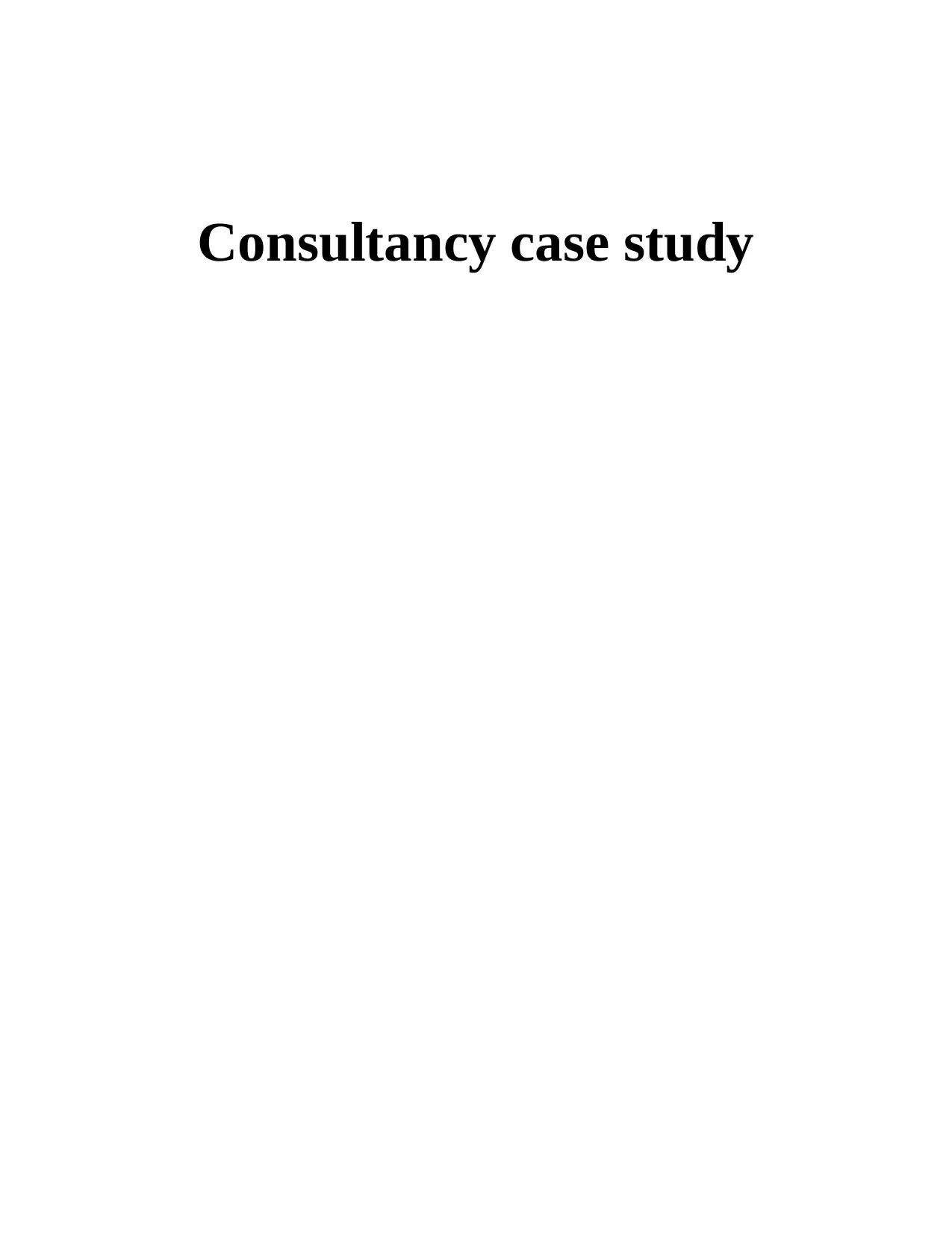
Consultancy case study
Paraphrase This Document
Need a fresh take? Get an instant paraphrase of this document with our AI Paraphraser
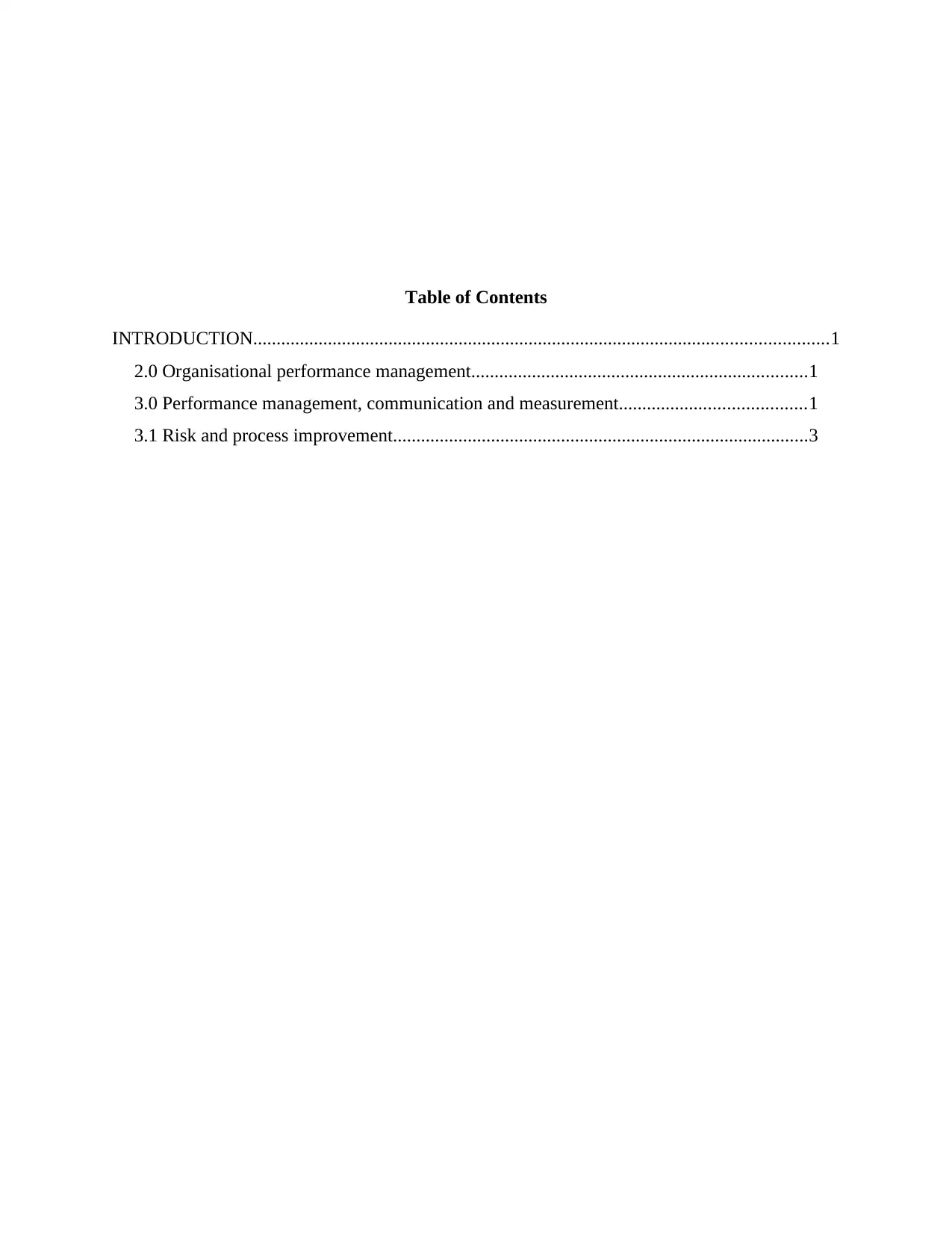
Table of Contents
INTRODUCTION...........................................................................................................................1
2.0 Organisational performance management........................................................................1
3.0 Performance management, communication and measurement........................................1
3.1 Risk and process improvement.........................................................................................3
INTRODUCTION...........................................................................................................................1
2.0 Organisational performance management........................................................................1
3.0 Performance management, communication and measurement........................................1
3.1 Risk and process improvement.........................................................................................3
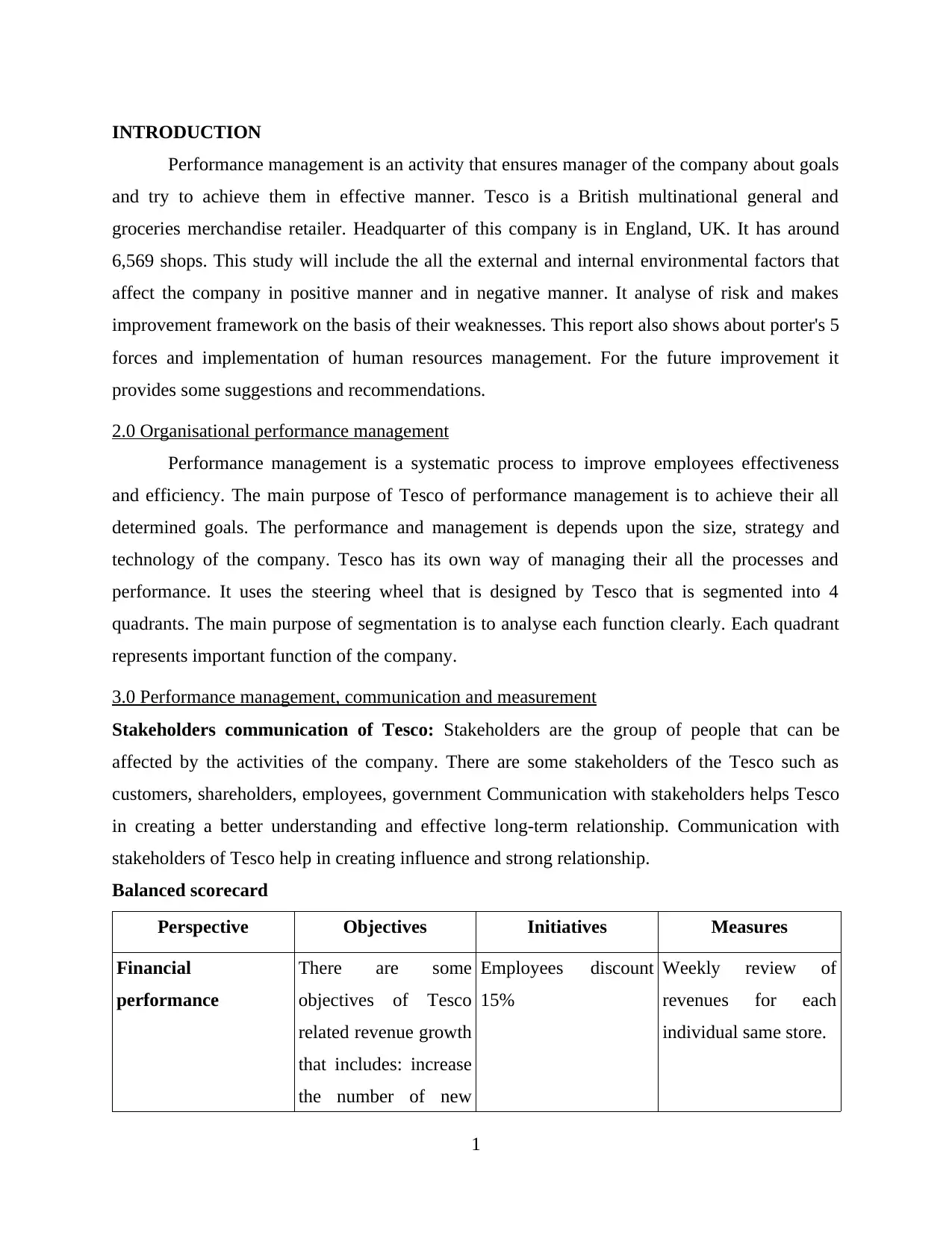
INTRODUCTION
Performance management is an activity that ensures manager of the company about goals
and try to achieve them in effective manner. Tesco is a British multinational general and
groceries merchandise retailer. Headquarter of this company is in England, UK. It has around
6,569 shops. This study will include the all the external and internal environmental factors that
affect the company in positive manner and in negative manner. It analyse of risk and makes
improvement framework on the basis of their weaknesses. This report also shows about porter's 5
forces and implementation of human resources management. For the future improvement it
provides some suggestions and recommendations.
2.0 Organisational performance management
Performance management is a systematic process to improve employees effectiveness
and efficiency. The main purpose of Tesco of performance management is to achieve their all
determined goals. The performance and management is depends upon the size, strategy and
technology of the company. Tesco has its own way of managing their all the processes and
performance. It uses the steering wheel that is designed by Tesco that is segmented into 4
quadrants. The main purpose of segmentation is to analyse each function clearly. Each quadrant
represents important function of the company.
3.0 Performance management, communication and measurement
Stakeholders communication of Tesco: Stakeholders are the group of people that can be
affected by the activities of the company. There are some stakeholders of the Tesco such as
customers, shareholders, employees, government Communication with stakeholders helps Tesco
in creating a better understanding and effective long-term relationship. Communication with
stakeholders of Tesco help in creating influence and strong relationship.
Balanced scorecard
Perspective Objectives Initiatives Measures
Financial
performance
There are some
objectives of Tesco
related revenue growth
that includes: increase
the number of new
Employees discount
15%
Weekly review of
revenues for each
individual same store.
1
Performance management is an activity that ensures manager of the company about goals
and try to achieve them in effective manner. Tesco is a British multinational general and
groceries merchandise retailer. Headquarter of this company is in England, UK. It has around
6,569 shops. This study will include the all the external and internal environmental factors that
affect the company in positive manner and in negative manner. It analyse of risk and makes
improvement framework on the basis of their weaknesses. This report also shows about porter's 5
forces and implementation of human resources management. For the future improvement it
provides some suggestions and recommendations.
2.0 Organisational performance management
Performance management is a systematic process to improve employees effectiveness
and efficiency. The main purpose of Tesco of performance management is to achieve their all
determined goals. The performance and management is depends upon the size, strategy and
technology of the company. Tesco has its own way of managing their all the processes and
performance. It uses the steering wheel that is designed by Tesco that is segmented into 4
quadrants. The main purpose of segmentation is to analyse each function clearly. Each quadrant
represents important function of the company.
3.0 Performance management, communication and measurement
Stakeholders communication of Tesco: Stakeholders are the group of people that can be
affected by the activities of the company. There are some stakeholders of the Tesco such as
customers, shareholders, employees, government Communication with stakeholders helps Tesco
in creating a better understanding and effective long-term relationship. Communication with
stakeholders of Tesco help in creating influence and strong relationship.
Balanced scorecard
Perspective Objectives Initiatives Measures
Financial
performance
There are some
objectives of Tesco
related revenue growth
that includes: increase
the number of new
Employees discount
15%
Weekly review of
revenues for each
individual same store.
1
⊘ This is a preview!⊘
Do you want full access?
Subscribe today to unlock all pages.

Trusted by 1+ million students worldwide
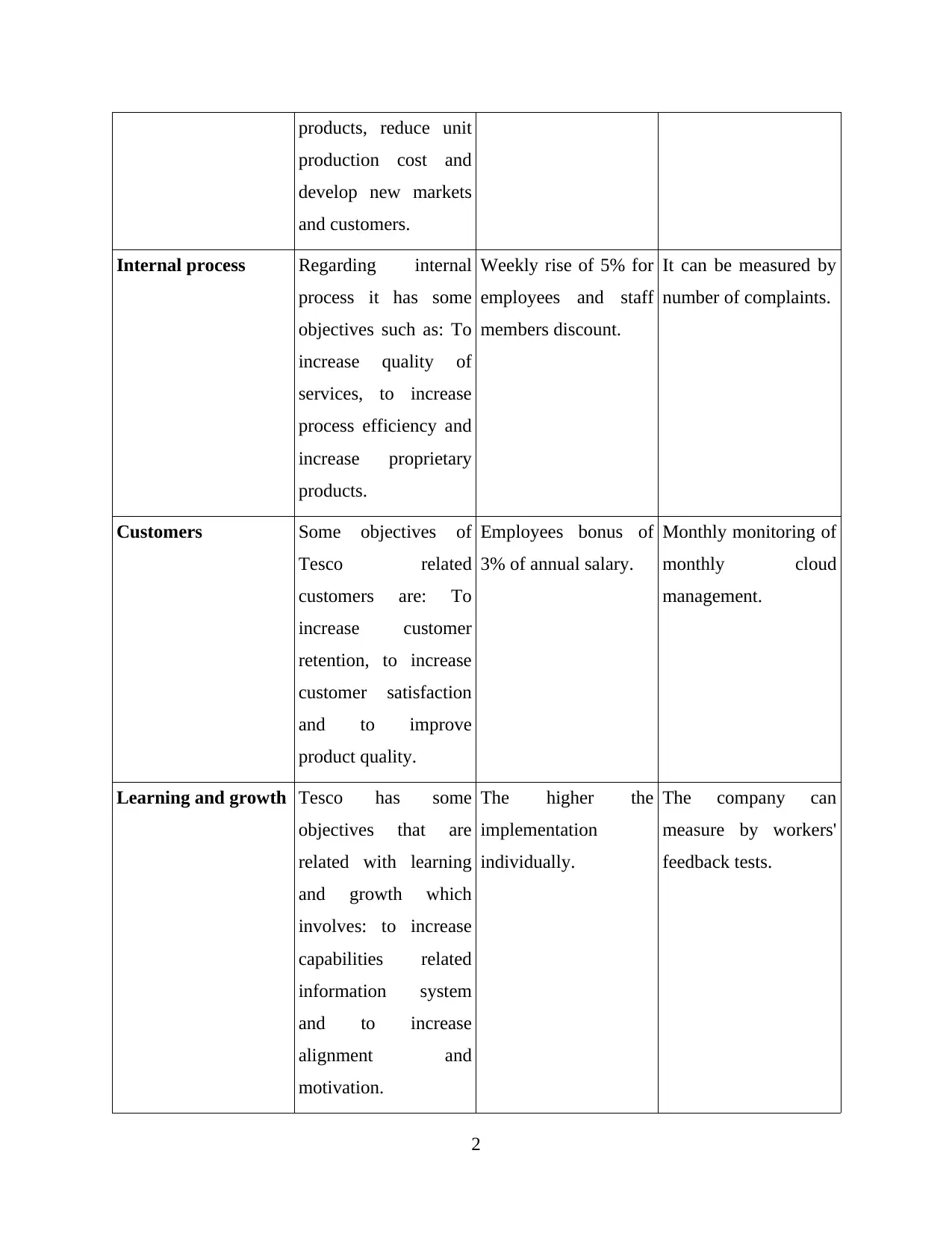
products, reduce unit
production cost and
develop new markets
and customers.
Internal process Regarding internal
process it has some
objectives such as: To
increase quality of
services, to increase
process efficiency and
increase proprietary
products.
Weekly rise of 5% for
employees and staff
members discount.
It can be measured by
number of complaints.
Customers Some objectives of
Tesco related
customers are: To
increase customer
retention, to increase
customer satisfaction
and to improve
product quality.
Employees bonus of
3% of annual salary.
Monthly monitoring of
monthly cloud
management.
Learning and growth Tesco has some
objectives that are
related with learning
and growth which
involves: to increase
capabilities related
information system
and to increase
alignment and
motivation.
The higher the
implementation
individually.
The company can
measure by workers'
feedback tests.
2
production cost and
develop new markets
and customers.
Internal process Regarding internal
process it has some
objectives such as: To
increase quality of
services, to increase
process efficiency and
increase proprietary
products.
Weekly rise of 5% for
employees and staff
members discount.
It can be measured by
number of complaints.
Customers Some objectives of
Tesco related
customers are: To
increase customer
retention, to increase
customer satisfaction
and to improve
product quality.
Employees bonus of
3% of annual salary.
Monthly monitoring of
monthly cloud
management.
Learning and growth Tesco has some
objectives that are
related with learning
and growth which
involves: to increase
capabilities related
information system
and to increase
alignment and
motivation.
The higher the
implementation
individually.
The company can
measure by workers'
feedback tests.
2
Paraphrase This Document
Need a fresh take? Get an instant paraphrase of this document with our AI Paraphraser
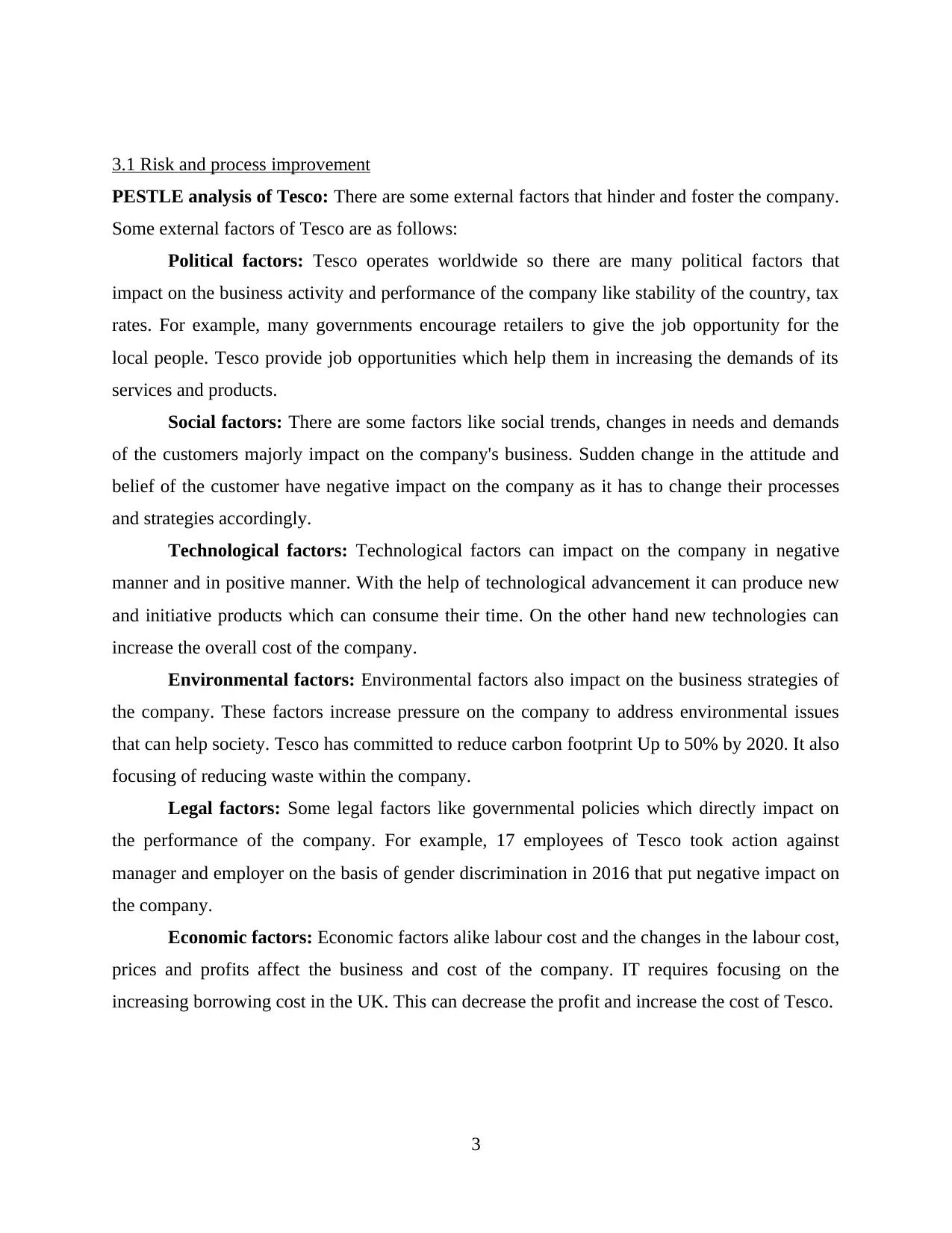
3.1 Risk and process improvement
PESTLE analysis of Tesco: There are some external factors that hinder and foster the company.
Some external factors of Tesco are as follows:
Political factors: Tesco operates worldwide so there are many political factors that
impact on the business activity and performance of the company like stability of the country, tax
rates. For example, many governments encourage retailers to give the job opportunity for the
local people. Tesco provide job opportunities which help them in increasing the demands of its
services and products.
Social factors: There are some factors like social trends, changes in needs and demands
of the customers majorly impact on the company's business. Sudden change in the attitude and
belief of the customer have negative impact on the company as it has to change their processes
and strategies accordingly.
Technological factors: Technological factors can impact on the company in negative
manner and in positive manner. With the help of technological advancement it can produce new
and initiative products which can consume their time. On the other hand new technologies can
increase the overall cost of the company.
Environmental factors: Environmental factors also impact on the business strategies of
the company. These factors increase pressure on the company to address environmental issues
that can help society. Tesco has committed to reduce carbon footprint Up to 50% by 2020. It also
focusing of reducing waste within the company.
Legal factors: Some legal factors like governmental policies which directly impact on
the performance of the company. For example, 17 employees of Tesco took action against
manager and employer on the basis of gender discrimination in 2016 that put negative impact on
the company.
Economic factors: Economic factors alike labour cost and the changes in the labour cost,
prices and profits affect the business and cost of the company. IT requires focusing on the
increasing borrowing cost in the UK. This can decrease the profit and increase the cost of Tesco.
3
PESTLE analysis of Tesco: There are some external factors that hinder and foster the company.
Some external factors of Tesco are as follows:
Political factors: Tesco operates worldwide so there are many political factors that
impact on the business activity and performance of the company like stability of the country, tax
rates. For example, many governments encourage retailers to give the job opportunity for the
local people. Tesco provide job opportunities which help them in increasing the demands of its
services and products.
Social factors: There are some factors like social trends, changes in needs and demands
of the customers majorly impact on the company's business. Sudden change in the attitude and
belief of the customer have negative impact on the company as it has to change their processes
and strategies accordingly.
Technological factors: Technological factors can impact on the company in negative
manner and in positive manner. With the help of technological advancement it can produce new
and initiative products which can consume their time. On the other hand new technologies can
increase the overall cost of the company.
Environmental factors: Environmental factors also impact on the business strategies of
the company. These factors increase pressure on the company to address environmental issues
that can help society. Tesco has committed to reduce carbon footprint Up to 50% by 2020. It also
focusing of reducing waste within the company.
Legal factors: Some legal factors like governmental policies which directly impact on
the performance of the company. For example, 17 employees of Tesco took action against
manager and employer on the basis of gender discrimination in 2016 that put negative impact on
the company.
Economic factors: Economic factors alike labour cost and the changes in the labour cost,
prices and profits affect the business and cost of the company. IT requires focusing on the
increasing borrowing cost in the UK. This can decrease the profit and increase the cost of Tesco.
3
1 out of 5
Related Documents
Your All-in-One AI-Powered Toolkit for Academic Success.
+13062052269
info@desklib.com
Available 24*7 on WhatsApp / Email
![[object Object]](/_next/static/media/star-bottom.7253800d.svg)
Unlock your academic potential
Copyright © 2020–2025 A2Z Services. All Rights Reserved. Developed and managed by ZUCOL.





